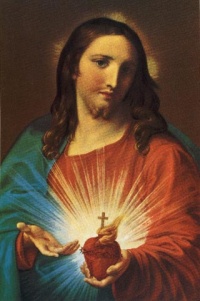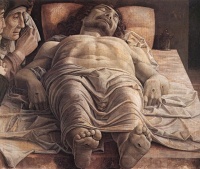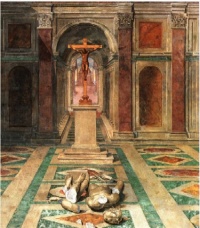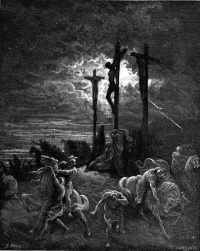Jesus
From The Art and Popular Culture Encyclopedia

|
"And great multitudes came unto him, having with them those that were lame, blind, dumb, maimed, and many others, and cast them down at Jesus’ feet; and he healed them...(Matthew 15: 30)" cited in The Holy Bible (1865) by Gustave Doré "In a general sense, it is therefore true to say that Jesus was only thaumaturgus and exorcist in spite of himself."--The Life of Jesus (1863) by Ernest Renan "In short, the nature of the hallucinations of Jesus, as they are described in the orthodox Gospels, permits us to conclude that the founder of Christian religion was afflicted with religious paranoia."--Charles Binet-Sanglé cited in The Psychiatric Study of Jesus (1913) by Albert Schweitzer "William Hirsch makes a diagnosis of Jesus, namely, paranoia. Everything that we know about him conforms so perfectly to the clinical picture of paranoia that it is hardly conceivable that people can even question the accuracy of the diagnosis."-- The Psychiatric Study of Jesus (1913) by Albert Schweitzer "In this place known as Golgotha, many have met the same cruel fate and many others will follow them, but this naked man, nailed by hands and feet to a cross, the son of Joseph and Mary, named Jesus, is the only one whom posterity will remember and honor by inscribing his initials in capitals."--The Gospel According to Jesus Christ (1991) by José Saramago "In short, the nature of the hallucinations of Jesus, as they are described in the orthodox Gospels, permits us to conclude that the founder of Christian religion was afflicted with religious paranoia."--Charles Binet-Sanglé cited in The Psychiatric Study of Jesus (1913) by Albert Schweitzer |
.jpg)



Illustration: Triumph of Christianity (detail) by Tommaso Laureti (1530-1602.)
Jesus Christ (6–4 BC to 30–33 AD), also called Jesus of Nazareth, is the central figure in Christianity.
According to the New Testament, Jesus is the Son of God who served a ministry in Galilee and Judaea and was ultimately crucified in Jerusalem by order of the Roman governor Pontius Pilate before rising from the dead three days later.
Depiction in art
The image of a fully-bearded Jesus with long hair did not become established until the 6th century in Eastern Christianity, and much later in the West. Earlier images were much more varied. Images of Jesus tend to show ethnic characteristics similar to those of the culture in which the image has been created. Beliefs that certain images are historically authentic, or have acquired an authoritative status from church tradition, remain powerful among some of the faithful, in both Eastern Orthodoxy and Roman Catholicism. The Shroud of Turin is now the best-known example, though the Image of Edessa and the Veil of Veronica were better known in medieval times.
There has been a long tradition of featuring Jesus in paintings and sculpture, ranging from the Roman catacombs and the conservative icon tradition of the Orthodox world through medieval altarpieces to modern acrylics. Many images depict the Life and Passion of Christ, especially the Crucifixion of Christ, whilst others show the infant Christ with his mother (Madonna and Child) or Christ in Majesty. Many of the most famous paintings in Western art feature Christ. The tradition continues in professional and folk art in many countries, as well as popular commercial imagery. Most images, whatever their origins, (as left) keep fairly close to the conventional appearance (and clothing) of Christ established in Byzantine art by about 400AD, which is now instantly recognisable.
Protestant Christians (following reformers such as John Calvin and Zwingli) frequently reject many depictions of Jesus as a form of idolatry (cf the Ten Commandments).
See also

_by_Henry_de_Groux.JPG)
